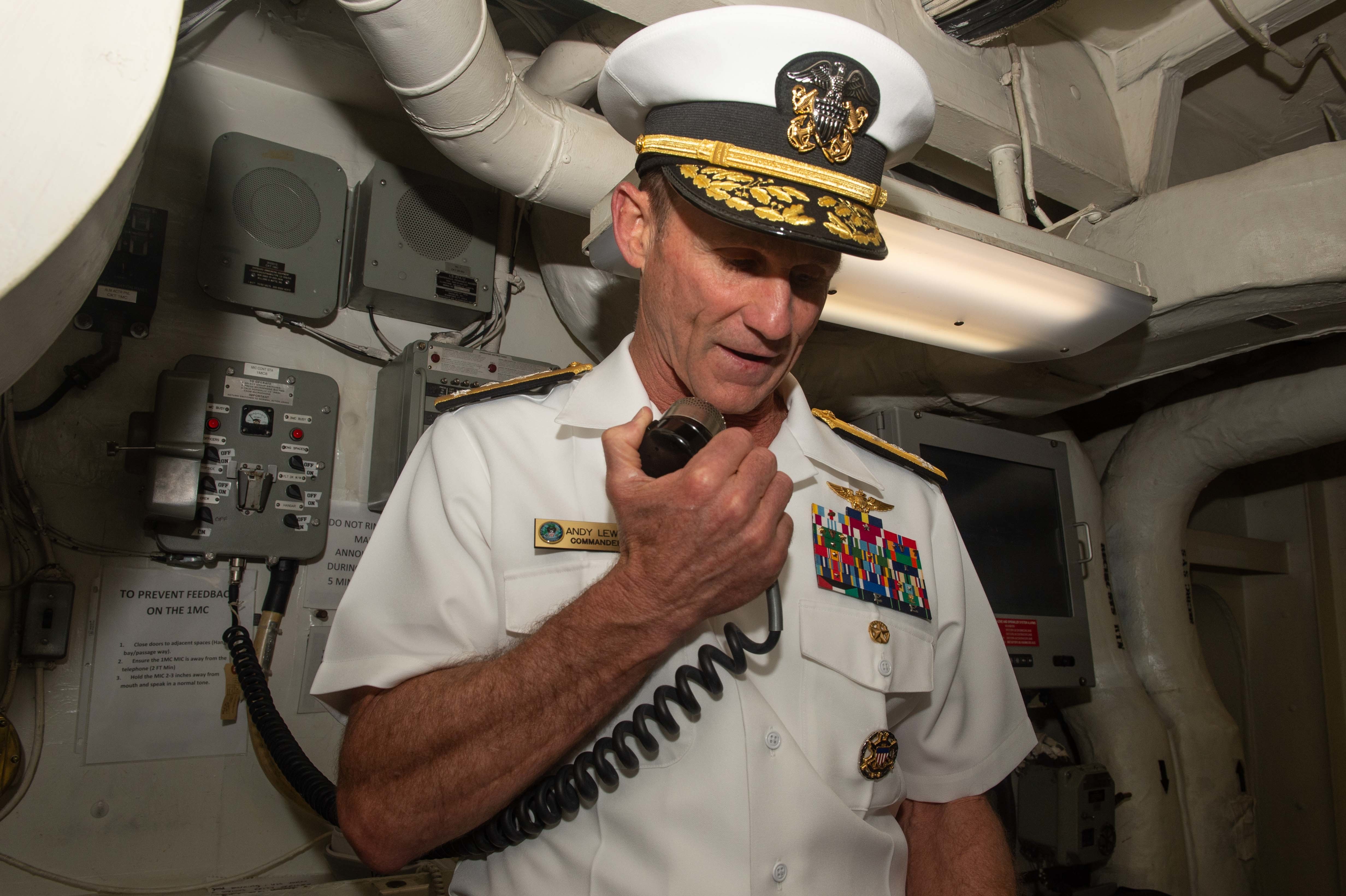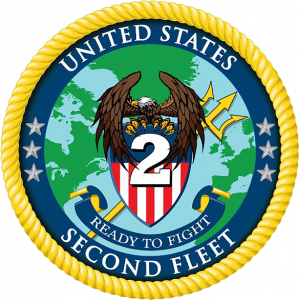
NAVAL STATION NORFOLK, Va. – A year after it was established, the reborn U.S. 2nd Fleet has reached an initial operational capability ahead of leading a major European exercise next month.
The designation means the command, led by Vice Adm. Andrew “Woody” Lewis, will be able to command and control naval forces on its own, the Navy said.
“U.S. 2nd Fleet exercises operational and administrative authorities over assigned ships, aircraft and landing forces on the East Coast and the North Atlantic. Additionally, it plans and conducts maritime, joint and combined operations as well as trains and recommends certification of combat-ready naval forces for maritime employment and operations around the globe,” reads a statement from 2nd Fleet.
“By focusing on the high-end training and employment of assigned assets, the new 2nd Fleet will be postured to support the employment of forces, whether that is on the western side of the Atlantic, the eastern side of the Atlantic or up into the Arctic.”
Announced in May 2018, the new numbered fleet was created as the Russian submarine threat in the Atlantic has grown, with Moscow fielding a new and more capable fleet of attack boats armed with long-range cruise missiles that can threaten mainland Europe. The activation of the command followed the declaration of a new era of great power competition by then-Secretary of Defense James Mattis that put Russia and China at the forefront of U.S. planning.
“The North Atlantic has some of the world’s busiest shipping lanes, and with the opening of waterways in the Arctic, this traffic will only grow,” Lewis said in a statement. “This is a fact acknowledged by both our allies and competitors, and as such, it is critically important U.S. 2nd Fleet reinvigorates the way our forces are employed in this influential theater.”

While the boundaries and overlap of responsibility of 2nd Fleet and the Italy-based U.S. 6th Fleet are still in flux, there are indications that 2nd Fleet will command and control forces from Norfolk, past the Greenland-Iceland-U.K. gap and into the Arctic and Barents Seas to support a theater anti-submarine warfare mission.
Lewis told reporters Wednesday in Norfolk that both Chinese and Russian aspirations played into the creation of 2nd Fleet, but Russia in particular was a focus for his command.
The Navy has been reluctant to talk about the specifics of the Russian threat, but in particular the newest generation of Russian attack submarines are armed with long-range land-attack missiles that can put a significant number of allied cities at risk. Less well-known is the Russians’ work in developing a new class of underwater strategic weapons, described as a high-speed nuclear torpedo.
“Very specifically with the Russian competitors, in the maritime they are proficient undersea operators,” Lewis said.
To that end, Lewis said he was under a mandate to create a command and control structure that would transcend the geographic boundary between the eastern and western Atlantic – traditionally a dividing line marked by a line of longitude drawn from the southern point of Greenland.
“Seams, by definition, whether they be geographic seams, domain seams, whatever the case may be, create vulnerabilities for our adversaries and our competitors to exploit,” he said.
“That’s where my focus is.”
Under the current construct, 2nd Fleet could report to either U.S. Fleet Forces Command commander Adm. Chris Grady through his naval commander role in U.S. Northern Command, or to Adm. James Foggo through his role as the commander of naval forces in U.S. European Command.
However, there is a clear emphasis on the North Atlantic and the Arctic.
“We have to take a measured and deliberate approach to be operating up there,” he said about the Arctic.
“I would not say that it’s a competitive space right now, but it’s approaching a competitive space and what we need to be able to do is operate there professionally and safely and in order to maintain it as place of freedom of navigation under international law. We can’t do that virtually.”
While actual physical boundary between the two commands are still a work in progress, Lewis’ focus is very clear.
“To stay focused on the generation and employment of the forces on the high-end of naval warfare is the reason for it,” he said.
The declaration comes ahead of next month’s Baltic Operations (BALTOPS) exercise, which will be led by 2nd Fleet and include NATO and other partner nations centered around the Baltic Sea.
“BALTOPS 2019 is our collective opportunity to promote peace and security through cooperation, collaboration, interoperability, and an unambiguous display of strength in the Baltic region,” Lewis said in the statement. “As an alliance, increasing our capabilities across all domains as well as building a command-wide network will give us the ability to deter aggression and project stability.”
In addition to leading the operational fleet, Lewis also commands Joint Force Command Norfolk as part of the overall NATO military command structure.
The following is the complete statement from U.S. 2nd Fleet.
U. S. 2nd Fleet Declares Initial Operational Capability
From U.S. 2nd Fleet Public Affairs
NORFOLK, Va. – U.S. 2nd Fleet declared the command has achieved initial operational capability (IOC) May 29, 2019, less than one year after being established by senior military leaders.
Vice Adm. Andrew “Woody” Lewis, commander, U.S. 2nd Fleet, made the announcement onboard Naval Station Norfolk, Va., the waterfront homeport of many 2nd Fleet maritime assets.
“The North Atlantic has some of the world’s busiest shipping lanes, and with the opening of waterways in the Arctic, this traffic will only grow,” said Lewis. “This is a fact acknowledged by both our allies and competitors, and as such, it is critically important U.S. 2nd Fleet reinvigorates the way our forces are employed in this influential theater.”
In achieving IOC, the command has reached the capability to command and control forces assigned, as is expected of a numbered fleet, utilizing the functions and processes of the Maritime Operations Center and Maritime Headquarters.
By focusing on the high-end training and employment of assigned assets, the new 2nd Fleet will be postured to support the employment of forces, whether that is on the Western side of the Atlantic, the Eastern side of the Atlantic, or up into the Arctic.
A few days after achieving IOC, the new Fleet will lead Exercise Baltic Operations (BALTOPS), marking the first time the Fleet will operate in the European theater, and leveraging increased lethality, interoperability and integrated warfighting capability with allies and partners in the region.
“BALTOPS 2019 is our collective opportunity to promote peace and security through cooperation, collaboration, interoperability, and an unambiguous display of strength in the Baltic region,” said Lewis. “As an alliance, increasing our capabilities across all domains as well as building a command-wide network will give us the ability to deter aggression and project stability.”
U.S. 2nd Fleet exercises operational and administrative authorities over assigned ships, aircraft and landing forces on the East Coast and the North Atlantic. Additionally, it plans and conducts maritime, joint and combined operations as well as trains and recommends certification of combat-ready naval forces for maritime employment and operations around the globe.





